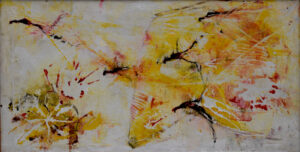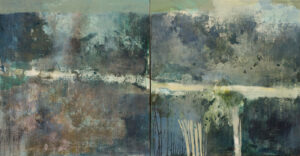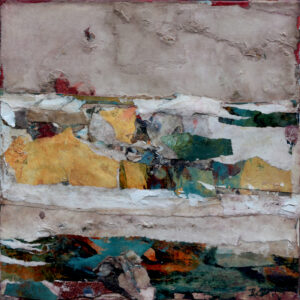Notes from the Studio

Flying Birds (1964) Oil on canvas, 40 x 75 cm

Les Eyzies, VIII, Acrylic on paper, 30 x 30 cm

Les Eyzies I, Oil on 2 canvases, 100 x 200 cm

Les Eyzies IX, acrylic on paper, 30 x 30 cm
All paintings by Robin Richmond.
After being told by my doctor 20 years ago that I’d become allergic to oil paint – a diagnosis that was devastating at the time – I have been painting in oils again for the past few months. It’s wonderful.
I have to be surgeon-like and use medical gloves, which feels rather too clinical, but this way I can do it. And I love it. It is fine. No swollen eyes and scabbed, burned hands.
Of course, I still use acrylics and water-based paint for works on paper, but coming back to oil on canvas has been thrilling. My very first painting on a canvas “liberated” (stolen) from my mother’s studio in Rome years ago, is an oil. This is Flying Birds, a painting from 1964. This hangs permanently in my French studio. Maybe being called Robin has something to do with my preoccupation with the notion of flying. Birds occur in most of my early work. Escape? Freedom? Floating? Ungrounded?
This past summer I have been swimming and paddling my canoe, and walking in the woods, which brings me close to the ground but also close to water. I am fascinated by the way water cuts through limestone. It seems impossible. I am intrigued by rocks and glaciers, currents and waves, and the weight of water. The way carbon dioxide combines with rain to create a weak acid that makes huge caves in the limestone is mystifying. Canoeing along the rivers reveals fissures and caverns in the rock that one cannot see any other way. It’s a different way of seeing. Revelatory. Numinous. Magical.
The landscape that I see from my studio in France is profoundly rural, silent and wooded and with huge ever-changing skies. The big series of paintings that has been my focus this past late Spring and Summer is called Les Eyzies, which is the name of a small village at the confluence of the Vézère and Beune rivers, near Montignac, site of the world-famous UNESCO listed Lascaux caves. Around here they like to call this part of France “le pays de l’homme” because there is so much evidence of human prehistory here. Man-made artefacts, Cro-Magnon skulls, and even a human foetus from this mid Stone Age period have been found in the valley of the Vezère. There are standing stones everywhere. Cave paintings and carvings dating from around 20,000 years ago can be seen in the Grotte du Grand Roc, Font de Gaume, Rouffignac and L’Abri du Poisson. Some people describe these sites as the birthplace of art. I am not sure that is what they are. This is a controversial topic among both art historians and anthropologists, but they give me huge energy as an artist.
I think all this is probably what drew me here 36 years ago. I have 3 recurring dreams. One is very common I am told. I am flying high over a landscape. Yes, I am a landscape painter called Robin who likes an aerial, bird’s eye view. A case of nominative determinism? Another dream is that I come across an undiscovered room in my house. Full of riches. Pretty obvious that one. But my most cherished dream is that I discover a cave full of paintings. Lascaux, dear and near to me, was discovered in 1940 in Montignac by four teenagers playing catch with their little dog Robot.
Sadly, up until now I have been completely unsuccessful. I row my canoe in hope and keep painting, bearing in mind Picasso’s typically pithy comment on the paintings in the caves:
“We have invented nothing.”
